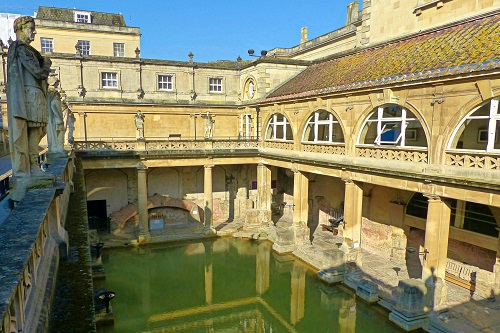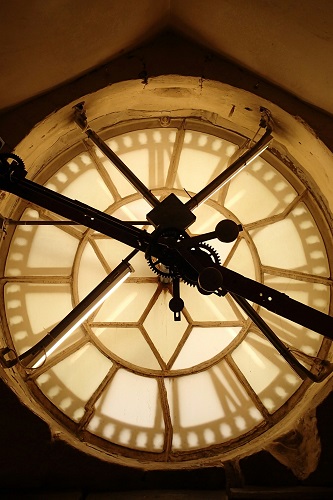Some cultures, like the Romans and Greeks, are famed for their cleanliness and love of bathing. Us Brits on the other hand are better known for being filthy. Even Queen Elizabeth I bathed just once a month, whether she 'needed to or not'! Despite its poor reputation, Britain has had a hot spring resort for nearly 2000 years. What is less surprising however is that the Romans built it. Once named Aquae Sulis in honour of the Celtic Goddess of hot springs, the city is now more aptly known as Bath. After falling in love with hot springs in Japan, we decided to find out what the best of British bathing had to offer.
The Roman Baths
We started with a visit to the Roman Baths. Walking through the excavated remains of a Roman courtyard, we reached the temple of Sulis Minerva and saw the original sacrificial altar. The adjacent sacred spring was a steaming pool of uninviting green. In Roman times, people would throw offerings and curse tablets into the pool, much like a wishing well. Curse tablets were inscribed by the victims of crimes asking the goddess to deliver justice. Most of them were written by people who had their clothes stolen whilst bathing.

The Great Bath
Although the complex includes many pools and saunas, it's the Great Bath that is most memorable. This huge lead-lined pool was the centrepiece of the spa. Amazingly, it's still fully functional but was closed for bathing after a dangerous bacteria was discovered in the water. The Great Bath is a very impressive sight with statues of prominent Romans looking down from the terrace above. These were a Georgian addition to give the bath a more authentic Roman feel.
Bath: A Georgian Spa Resort
In the 1700s, Bath became very popular with the Georgian gentry. The ancient Roman Baths were reopened as a spa and tourist attraction. We took a walk around the city to see some of Bath's famous Georgian architecture. The circular lawn of The Circus is surrounded by town houses, inspired by the Colosseum in Rome. Hundred of small carvings form an unbroken row along the face of the houses. We saw swords, serpents and harps among many others. When viewed from above, The Circus and nearby Queen's Square form the shape of a key. This was one of many masonic symbols hidden in the architect's work. The Royal Crescent is another grand example of town houses from Georgian Bath.

The Circus
The City of Bath
We wandered through the cobbled streets in the centre of Bath and took a short cut through Guildhall Market. Stallholders have been trading here for the last 800 years but we didn't find it particularly inspiring. A walk across Pulteney Bridge was more interesting. Tiny shops line both sides of Pulteney Bridge so you can't actually see the river. This gave us a great excuse to stop at a teashop on the bridge. It was so narrow we could almost touch both walls but it did mean that every table was close to a window with a good view over the river.
Bath Abbey
The nearby Bath Abbey has a beautifully carved facade, complete with angels climbing stairways to heaven. We took their tower tour, which was surprisingly good. Along with the great views over the city that we were expecting, we got to see some of the hidden nooks and crannies of the church. We looked around the bell ringing chamber and then crammed into a tiny hidden room to see the back of the church clock. While many people rave about the spectacular fan vaulted ceiling of Bath Abbey, we had more fun peering down through secret holes in this ceiling. The bell ringers used these holes to keep an eye on the proceedings below.

Behind Bath Abbey Clock
Taking A Bath In Bath
Even though there are numerous springs, there's only one place in town where you can actually take a bath, the Thermae Bath Spa. We weren't completely sold on the shiny modern bathing complex so we opted for the more traditional option. The Cross Bath is a small pool dating from Georgian times. To begin with, we were the only people sitting in the warm open-air pool. We relaxed, admiring the well weathered carvings on the stone walls surrounding us and watching the typical steely grey English sky scroll past overhead. In time, a few more bathers joined us but everyone was very quiet and just enjoying the peaceful experience. Although the pool was warm, the cool spring air eventually took its toll and we retreated inside.
With its long history, stunning architecture and well preserved Roman sites it's no surprise that the whole city of Bath has been designated a World Heritage Site. Bath attracts visitors from all over the world so the main sights are very busy. We were glad we persevered with the queues.

River Avon
Where To Eat In Bath
Adjacent to the Roman Baths, The Pump Room is an elegant 18th century restaurant. We had lunch there and enjoyed the musical accompaniment. Lunch even included a glass of warm spa water served fresh from the King's Spring. Next time we'll try their afternoon tea instead.
Bath has its own famous buns, large sweet rolls served with toppings ranging from lemon curd to ham and piccalilli. We ate Bath Buns at Sally Lunn's, bakers of the first bun back in the 1700s. It's very popular so there's nearly always a queue. They do have a lot of tables though so we didn't have to wait long.
Where To Take A Bath In Bath
The Thermae Bath Spa is the only place to bathe in a hot spring in Bath. It's common to queue for an hour or more to experience the delights of this ultra modern, multi-level complex. We got there early in the morning, before the complex opened. There was still a queue but it was a lot shorter.
Most crowd into the open air pool on the rooftop, one of the best vantage points for views across the city but there is also an indoor bath, complete with whirlpool and lazy river. We opted for the Cross Bath across the road. It's a tiny open air pool that dates from Georgian times. We still had to queue at Thermae Bath Spa but with numbers limited to just 12 bathers, the Cross Bath was really relaxing.
